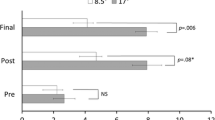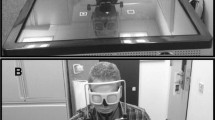Abstract
While patients with right parietal damage and spatial neglect bisect lines to the right, the general population bisects lines to the left; a phenomenon known as pseudoneglect. The leftward bias also occurs for mental representations, such as number and alphabet lines. Prismatic adaptation can have a dramatic effect on attentional bias and corrects neglect and pseudoneglect for physical and mental number lines. This study examined whether prismatic adaptation can correct leftward bisection biases for alphabet lines, which may have a different spatial arrangement compared to number lines. In pre-adaptation testing, students (n = 42) were shown letter trigrams (e.g. C H P) and judged whether the alphabetical distance before or after the inner-letter was larger. Participants were then split into three groups and were adapted to left-shifting, control or right-shifting prims. After adaptation, the mental alphabet bisection task was re-administered. The length of left side of the alphabet lines was overestimated by all three groups in the pre-adaptation phase. Right-shifting prisms and control spectacles had no effect on the leftward bias whereas exposure to left-shifting prisms corrected the bias. The results replicate an effect observed for mental number lines and demonstrate that low-level sensory-motor shifts can correct attentional biases associated with high-level representations, such as letters.


Similar content being viewed by others
References
Bartolomeo P, Bachoud-Lévi A, Azouvi P, Chokron S (2005) Time to imagine space: a chronometric exploration of representational neglect. Neuropsychologia 43:1249–1257
Berberovic N, Mattingley JB (2003) Effects of prismatic adaptation on judgements of spatial extent in peripersonal and extrapersonal space. Neuropsychologia 41:493–503
Bisiach E, Luzzatti C (1978) Unilateral neglect of representational space. Cortex 14:129–133
Bjoertomt O, Cowey A, Walsh V (2002) Spatial neglect in near and far space investigated by repetitive transcranial magnetic stimulation. Brain 125:2012–2022
Bowers D, Heilman KM (1980) Pseudoneglect: effects of hemispace on a tactile line bisection task. Neuropsychologia 18:491–498
Bultitude J, Aimola-Davies AM (2006) Putting attention on the line: investigating the activation–orientation hypothesis of pseudoneglect. Neuropsychologia 44:1849–1858
Colent C, Pisella L, Bernieri C, Rode G, Rossetti Y (2000) Cognitive bias induced by visuomotor adaptation to prisms: a simulation of unilateral neglect in normal individuals. Neuroreport 11:1899–1902
Dehaene S, Bossini S, Giraux P (1993) The mental representation of parity and number magnitude. J Exp Psychol Gen 122:371–396
Dodd MD, Van der Stigchel S, Leghari MA, Fung G, Kingstone A (2008) Attentional SNARC: there’s something special about numbers (let us count the ways). Cognition (in press)
Ferber S, Murray LJ (2005) Are perceptual judgments dissociated from motor processes? A prism adaptation study. Cogn Brain Res 23:453–456
Foxe JJ, McCourt ME, Javitt DC (2003) Parietal control of visuospatial attention: Line bisection judgments evaluated with high-density electrical mapping and source analysis. NeuroImage 19:710–726
Frassinetti F, Angeli V, Meneghello F, Avanzi S, Làdavas E (2002) Long-lasting amelioration of visuospatial neglect by prism adaptation. Brain 125:608–623
Gevers W, Reynvoet B, Fias W (2003) The mental representation of sequences is spatially organized. Cognition 87:87–95
Göbel SM, Calabria M, Farnè A, Rossetti Y (2006) Parietal rTMS distorts the mental number line: simulating spatial neglect in healthy subjects. Neuropsychologia 44:860–868
Halligan PW, Marshall JC (1988) How long is a piece of string? A study of line bisection in a case of visual neglect. Cortex 24:321–328
Heilman KM, Watson RT, Valenstein E (1993) Neglect and related disorders. In: Heilman KM, Valenstein E (eds) Clinical neuropsychology. Oxford University Press, New York, pp 279–336
Hubbard EM, Piazza M, Pinel P, Dehaene S (2005) Interactions between number and space in parietal cortex. Nature Rev Neurosci 6(6):435–448
Jewell G, McCourt ME (2000) Pseudoneglect: a review and meta-analysis of performance factors in line bisection tasks. Neuropsychologia 38:93–110
Loftus AM, Nicholls MER, Mattingley JB, Bradshaw JL (2008a) Left to right: representational biases for numbers and the effect of visuomotor adaptation. Cognition 107:1048–1058
Loftus A, Nicholls MER, Mattingley JB, Chapman HL, Bradshaw JL (2008b) Pseudoneglect for the bisection of mental number lines. Q J Exp Psychol (in press)
Longo MR, Lourenco SF (2007) Spatial attention and the mental number line: evidence for characteristic biases and compression. Neuropsychologia 45:1400–1407
McCourt ME (2001) Performance consistency of normal observers in forced-choice tachistoscopic visual line bisection. Neuropsychologia 39:1065–1076
McCourt ME, Garlinghouse M, Slater J (2000) Centripetal versus centrifugal bias in visual line bisection: focusing attention on two hypotheses. Front Biosci 5:D58–D71 (Special Issue on Selective Attention Mechanisms in the Primate)
McCourt ME, Jewell G (1999) Visuospatial attention in line bisection: stimulus modulation of pseudoneglect. Neuropsychologia 37:843–855
Nichelli P, Rinaldi M, Cubelli R (1989) Selective spatial attention and length representation in normal subjects and in patients with unilateral spatial neglect. Brain Cogn 9:57–70
Nicholls MER, Bradshaw JL, Mattingley JB (1999) Free-viewing perceptual asymmetries for the judgement of shade, numerosity and size. Neuropsychologia 37:307–314
Nicholls MER, Loftus A (2007) Pseudoneglect and neglect for mental alphabet lines. Brain Res 1152:130–138
Nijboer TCW, McIntosh RD, Nys GM, Dijkerman HC, Milner AD (2008) Prism adaptation improves voluntary but not automatic orienting in neglect. Neuroreport 19:293–298
Oldfield RC (1971) The assessment of handedness: the Edinburgh Inventory. Neuropsychologia 9:97–133
Pisella L, Rode G, Farnè A, Tilikete C, Rossetti Y (2006) Prism adaptation in the rehabilitation of patients with visuo-spatial cognitive disorders. Current Opin Neurol 19:534–542
Redding GM, Rossetti Y, Wallace B (2005) Applications of prism adaptation: a tutorial in theory and method. Neurosci Biobehav Rev 29:431–444
Rode G, Rossetti Y, Boisson D (2001) Prism adaptation improves representational neglect. Neuropsychologia 39:1250–1254
Rossetti Y, Jacquin-Coutois S, Rode G, Ota H, Michel C, Boisson D (2004) Does action make the link between number and space representation? Psychol Sci 15(6):426–430
Rossetti Y, Rode G, Pisella L, Farné A, Li L, Boisson D, Perenin M-T (1998) Prism adaptation to rightward optical deviation rehabilitates left hemispatial neglect. Nature 395:166–169
Serino A, Angeli V, Frassinetti F, Làdavas E (2006) Mechanisms underlying neglect recovery after prism adaptation. Neuropsychologia 44:1068–1078
Striemer C, Sablatnig J, Danckert J (2006) Differential influences of prism adaptation on reflexive and voluntary covert attention. J Int Neuropsychol Soc 12:337–349
Waberski TD, Gobbelé R, Lamberty K, Buchner H, Marshall JC, Fink GR (2008) Timing of visuo-spatial information processing: electrical source imaging related to line bisection judgements. Neuropsychologia 46:1201–1210
Zorzi M, Priftis K, Meneghell F, Marenzi R, Umilta C (2006) The Spatial representation of numerical and non-numerical sequences: evidence from Neglect. Neuropsychologia 44:1061–1067
Zorzi M, Priftis K, Umiltà C (2002) Neglect disrupts the mental number line. Nature 417:138–139
Author information
Authors and Affiliations
Corresponding author
Rights and permissions
About this article
Cite this article
Nicholls, M.E.R., Kamer, A. & Loftus, A.M. Pseudoneglect for mental alphabet lines is affected by prismatic adaptation. Exp Brain Res 191, 109–115 (2008). https://doi.org/10.1007/s00221-008-1502-x
Received:
Accepted:
Published:
Issue Date:
DOI: https://doi.org/10.1007/s00221-008-1502-x




